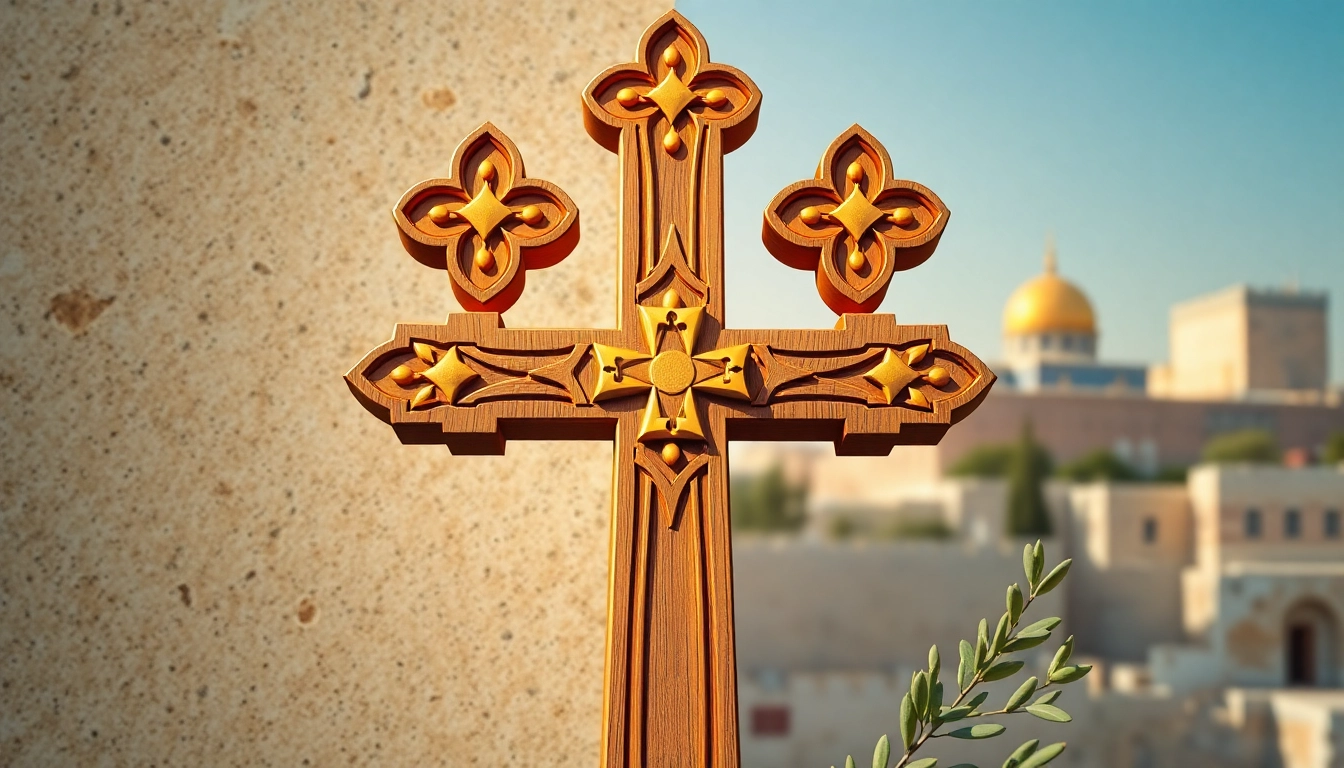The Historical Context of Jerusalem Crosses
The Jerusalem crosses are more than mere symbols; they embody a rich narrative that spans centuries of history and faith. As one of the most significant Christian symbols, the Jerusalem cross, also referred to as the “crusader’s cross,” showcases not only its distinct design but also its deep-rooted cultural and religious importance within the Christian faith.
Origin and Development Over Centuries
The origin of the Jerusalem cross can be traced back to the Crusades in the 11th century when it became emblematic of the Kingdom of Jerusalem, a historic Christian state established after the First Crusade. The cross features a large central cross potent that is surrounded by four smaller Greek crosses, reflecting the spread of Christianity from Jerusalem to the four corners of the earth. The symbolism behind this arrangement highlights the role of the Four Evangelists—Matthew, Mark, Luke, and John—who are instrumental in the dissemination of Christ’s teachings.
Over the centuries, the Jerusalem cross has seen various adaptations and interpretations in art and heraldry. Its use became prevalent not only in religious contexts but also in heraldry, where it often symbolizes Christian sovereignty and unity. As it spread across Europe and other regions, its design evolved, influencing local architectural and artistic traditions while retaining its core significance.
Cultural Significance in Christianity
The Jerusalem cross holds a special place within various Christian denominations, symbolizing the faith’s connection to the Holy Land. It serves as a reminder of the roots of Christianity and the historical narrative of Jesus Christ. Various churches and Christian organizations utilize the symbol to represent their mission of spreading the Gospel, especially across cultures and nations.
For example, the cross figure prominently in churches, on altars, and in liturgical items as a means of identifying Christian identity. Its usage has also transcended liturgical functions; some Christian communities adopt it as a symbol of faith and belonging, reflecting their dedication to the core teachings of Christ.
The Role of Jerusalem Crosses in Religious Rituals
In many Christian traditions, the Jerusalem cross plays a significant role in religious rituals and ceremonies. It is often used as a focal point during collective worship and personal devotion. The cross is not only an ornament; it embodies a sense of spirituality that invites believers to reflect on their faith, fostering a deeper connection to their beliefs during worship.
Additionally, the Jerusalem cross is frequently employed in blessing ceremonies, spiritual warfare prayers, and during commemorations of significant religious events, such as Easter and Christ’s ascension. Its presence in religious rituals serves as a tangible representation of faith, connecting the physical act of ritual with profound spiritual significance.
Exploring the Design of Jerusalem Crosses
Distinctive Features and Variations
The Jerusalem cross is characterized by its unique design, which comprises a large central cross intersected by four smaller crosses. Each component carries significant meaning, symbolizing the life and death of Christ juxtaposed with the call for evangelism.
Variations of the design exist across different cultures and periods. Some adaptations incorporate intricate details or embellishments, reflecting local artistry. For instance, in Eastern Orthodox traditions, cross designs might include ornate filigree or floral motifs, merging theological significance with artistic expression. Additionally, variations exist in how the crosses are proportioned, with some representing different theological emphases depending on the specific beliefs of the community.
Materials Used in Crafting
The Jerusalem cross is crafted from various materials, each adding its unique layer of meaning. Traditional artisans often employ olive wood, a material deeply associated with the Holy Land, symbolizing peace and endurance. Other common materials include metal, glass, and stone, each chosen for their aesthetic and spiritual qualities.
Crafters of Jerusalem crosses also utilize precious metals like gold and silver, especially in jewelry forms. These materials not only signify wealth and artistry but also emphasize the divine nature of the cross itself. The intricacies of each medium indicate the craftsmanship remains critical to preserving the cultural and historical significance of the Jerusalem cross.
Artistic Representations Across Cultures
The artistic representation of Jerusalem crosses is diverse across different cultures. From minimalist styles to heavily ornate designs, artists incorporate varying techniques and materials to express the cross’s significance. In many Christian communities, especially those located in the Holy Land, artisans blend local cultural symbols with religious artistry, creating pieces that resonate with both spiritual and artistic appreciation.
Furthermore, in modern contexts, we see the Jerusalem cross represented in various forms, such as wall hangings, digital art, and even fashion, where it becomes not just a symbol of faith but also a statement of individual identity. This contemporary artistic embrace showcases the Jerusalem cross’s lasting influence and its adaptability across generations.
Understanding the Symbolism of Jerusalem Crosses
Representations of the Four Evangelists
The four smaller crosses in the Jerusalem design hold rich symbolism correlating with the Four Evangelists. Each cross serves as a tribute to the authors of the Gospels, emphasizing their pivotal role in shaping Christian doctrine. Each Evangelist is often associated with a symbol—Matthew (man), Mark (lion), Luke (ox), and John (eagle)—and these symbols are sometimes represented alongside the Jerusalem cross.
This representation reinforces the belief that the teachings of Christ transcended geographical boundaries, highlighting His universal message. It serves as a reminder to Christians today of their mission to spread the Gospel, just as the Evangelists did in their time.
The Connection to the Holy Land
The Jerusalem cross profoundly links the Christian faith to the Holy Land, regarded as the heart and cradle of Christianity. The cross symbolizes not just a geographical landmark but a spiritual one, which holds the narratives of Christ’s life, ministry, and resurrection. The act of wearing or displaying a Jerusalem cross thus becomes an embodiment of faith, identity, and a connection to the historical foundations of Christianity.
Additionally, the unique history of Jerusalem as a site of pilgrimage for Christians further solidifies the cross’s significance. Each year, millions travel to the Holy City to experience the place where their faith originated, making the Jerusalem cross a potent symbol of hope and remembrance.
Modern Interpretations and Misunderstandings
In recent years, the Jerusalem cross has been subjected to various interpretations and, at times, misunderstandings. While it is a symbol of faith for many Christians, it has unfortunately also been co-opted by some groups for purposes that can be controversial. The cross’s historical ties to the Crusades often spark debates about its implications in modern dialogues about faith, nationalism, and identity.
This complexity highlights the necessity of approaching the Jerusalem cross with sensitivity and an understanding of its historical context. It is essential for contemporary Christians and scholars to engage with this symbol in a manner that emphasizes its spiritual significance while acknowledging the broader historical implications it may carry.
Jerusalem Crosses in Contemporary Culture
The Use in Jewelry and Fashion
In contemporary culture, the Jerusalem cross has transcended its traditional ecclesiastical boundaries to emerge as a popular motif in jewelry and fashion. Many designers incorporate the cross into modern accessories, such as necklaces, bracelets, and rings, allowing individuals to express their faith while embracing personal style.
Jewelry featuring the Jerusalem cross often serves as a powerful statement of belief, connecting the wearer to their faith in a fashionable manner. As a result, there has been a resurgence of interest in religious jewelry, with many seeking out authentic and symbolically rich pieces to adorn themselves.
Incorporation into Art and Media
The Jerusalem cross also finds its way into various forms of art and media. Its rich historical context and striking visual form provide a valuable source of inspiration for artists across disciplines. From paintings to sculptures, the Jerusalem cross appears in numerous portrayals, often embodying spiritual themes such as love, sacrifice, and hope.
In film and literature, the Jerusalem cross can symbolize character arcs or narratives centered around faith, redemption, or the historical implications of the Crusades. Its usage in public art installations further reflects the ongoing relevance of the cross in contemporary cultural discourse.
Public Perception and Controversies
As a potent symbol, the Jerusalem cross engenders various public reactions and controversies. While many view it as a profound emblem of faith, others express concern over its historical associations with colonialism and military conquests. Such perspectives highlight the importance of historical awareness and collective memory when discussing the Jerusalem cross’s impact.
Engaging in dialogue about the cross’s significance can foster understanding and ignited conversations surrounding faith, identity, and the nuances of religious symbolism in modern society. It is vital for communities to approach these discussions with an open mind and recognize the diversity of opinions surrounding symbols tied deeply to personal beliefs.
Where to Find Authentic Jerusalem Crosses
Buying from Reliable Sources
For those seeking authentic Jerusalem crosses, sourcing from reliable vendors is crucial. It is recommended to explore local church shops, religious gift stores, and artisans in the Holy Land who specialize in crafting these symbols. Such sources ensure that the cross retains its intended spiritual significance while supporting local artisans and communities.
Moreover, verifying the origin and craftsmanship authenticity of each piece is paramount. Many artisans happily share the story behind their creations, enhancing the understanding of the craftsmanship involved in producing each cross.
Craftsmen and Artisans in Jerusalem
In Jerusalem, numerous craftsmen specialize in creating Jerusalem crosses, often from olive wood sourced locally. Meeting these artisans provides a unique opportunity to learn about their techniques and the history behind their work. Buying directly from these artisans supports their livelihoods and preserves traditional craftsmanship. Notable artisans can often be found in locations such as the Old City, where generations of craftsmanship have flourished.
Online Retailers and Marketplaces
In an increasingly digital world, online retailers also offer authentic Jerusalem crosses. Websites specializing in religious artifacts and Holy Land products provide a wide array of options catering to various tastes and budgets. While shopping online, it is advisable to read customer reviews and check return policies to ensure that the purchased item meets expectations for quality and authenticity.
Furthermore, setting alerts for new products or engaging with social media pages of reputable artisans can provide insights into new stock availability, ensuring that the quest for a Jerusalem cross is both rewarding and fulfilling.



